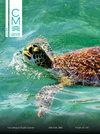基于复原力的珊瑚礁管理战略适用于哪些地方?绘制关岛和美属萨摩亚珊瑚覆盖的环境条件和趋势图
IF 0.7
4区 生物学
Q4 MARINE & FRESHWATER BIOLOGY
引用次数: 0
摘要
在压力日益增大的条件下,以恢复力为基础的管理策略作为提高珊瑚存活率和恢复能力的工具,正受到越来越多的关注。确定实施这些策略的优先地点取决于了解哪些地方的珊瑚已经显示出潜在的恢复力迹象,以及环境条件会如何随着气候变化而变化。我们利用目前的气候条件和两种未来气候情景,综合分析了关岛和美属萨摩亚的环境条件和珊瑚覆盖率趋势:代表浓度路径 4.5 和 8.5。我们研究了有利和不利环境条件之间的空间重叠,以及珊瑚礁在过去十年中保持或增加珊瑚覆盖率的地点。代表上述 4 种特征组合的地点可能会采取不同的管理策略:(1) 保护和恢复强健的珊瑚,(2) 恢复衰退的珊瑚,(3) 保护强健珊瑚的遗传物质并减轻压力,(4) 没有针对衰退珊瑚的明确策略。我们根据这些组合估算了可采取多种管理行动的区域。在目前的气候条件下,保护遗传物质和减轻压力在关岛的比例过高,占研究区域的 23%;而在未来的气候条件下,这一比例下降到 15%。珊瑚恢复最初所占比例较低(0%)。在美属萨摩亚,无论气候如何变化,每种战略的面积比例都保持一致。珊瑚恢复所占比例过高,占研究区域的 54% 至 56%,而遗传物质保护和压力缓解所占比例过低(分别为 9% 至 11%)。我们的方法提供了一种快速方法,可根据大空间范围内的汇总数据,评估潜在的管理行动可应用于哪些方面,这可以补充对珊瑚礁群落动态进行的更详细、更耗费人力的评估,特别是如果不同的珊瑚群落为汇总单元的边界提供了信息。这些结果可以指导管理者选择生态上合适的地点,以实施基于恢复力的珊瑚礁管理策略。本文章由计算机程序翻译,如有差异,请以英文原文为准。
Where are resilience-based management strategies appropriate for coral reefs? Mapping environmental conditions and trends in coral cover in Guam and American Samoa
Resilience-based management strategies are gaining attention as tools to improve coral survival and recovery under increasingly stressful conditions. Prioritizing locations to implement these strategies depends on knowing where corals already show potential signs of resilience and how environmental conditions may shift with climate change. We synthesized environmental conditions and coral cover trends in Guam and American Samoa using present-day climate conditions and 2 future climate scenarios: Representative Concentration Pathways 4.5 and 8.5. We examined the spatial overlap between favorable and unfavorable environmental conditions and locations where coral reefs have maintained or increased coral cover over the past decade. Locations representing 4 combinations of the aforementioned characteristics may be subject to different management strategies: (1) conservation and restoration of robust corals, (2) restoration of declining corals, (3) conservation of genetic material of robust corals and stressor mitigation, and (4) no clear strategy for declining corals. We estimated areas in which multiple management actions could be performed based on these combinations. Under present-day climate conditions, the conservation of genetic material and stressor mitigation were overrepresented in Guam, comprising 23% of the study area; this declined to 15% in future climate scenarios. Coral restoration was at first underrepresented (0%). In American Samoa, the proportional area for each strategy remained consistent regardless of climate. Coral restoration was overrepresented, comprising 54% to 56% of the study area, whereas the conservation of genetic material and stressor mitigation were underrepresented (9% to 11%, respectively). Our approach offers a rapid way to assess where potential management actions could be applied based on data aggregated over large spatial extents, which can complement more detailed, labor-intensive assessments of reef community dynamics, particularly if distinct coral communities inform the boundaries of aggregation units. These results may guide managers in selecting ecologically suitable locations for implementing resilience-based management strategies for coral reefs.
求助全文
通过发布文献求助,成功后即可免费获取论文全文。
去求助
来源期刊

Ciencias Marinas
生物-海洋与淡水生物学
CiteScore
1.10
自引率
0.00%
发文量
9
审稿时长
>12 weeks
期刊介绍:
A bilingual open-access publication, Ciencias Marinas (CM) is an international peer-reviewed journal that contains original research findings in all areas of marine science. It is published quarterly by the Autonomous University of Baja California, Mexico, and all its contents are publicly available on our journal website. Though a limited number of copies are still printed, the journal is mainly distributed in its electronic format.
CM was conceived in 1973 as part of an academic project aimed to entice local researchers to publicly disclose their findings by adopting the culture of peer-review publishing. This academic project evolved into an international journal after accepting papers from researchers in the United States and, eventually, other parts of the world. Because of the diversity in authorship, CM issues were initially published in either Spanish or English, and occasionally in both languages. It was not until 1984 when CM included both language versions of all its contents, and it then became the fully bilingual journal it still is today. At CM we believe our inclusive format allows us not only to address a wider range of submissions from international authors but also to make published findings available to a wider international audience.
So whether you are looking for information on the redfish in Icelandic waters or the physical and biological properties of the Gulf of California, feel free to peruse CM contents. You may find them to provide source material for your research.
 求助内容:
求助内容: 应助结果提醒方式:
应助结果提醒方式:


